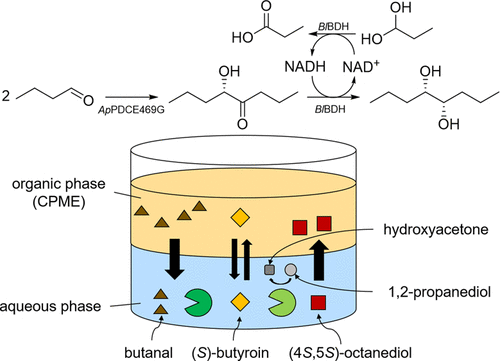当前位置:
X-MOL 学术
›
Org. Process Res. Dev.
›
论文详情
Our official English website, www.x-mol.net, welcomes your
feedback! (Note: you will need to create a separate account there.)
Enzymatic Cascade in a Simultaneous, One-Pot Approach with In Situ Product Separation for the Asymmetric Production of (4S,5S)-Octanediol
Organic Process Research & Development ( IF 3.1 ) Pub Date : 2022-03-15 , DOI: 10.1021/acs.oprd.1c00433 Jan-Dirk Spöring 1, 2 , William Graf von Westarp 3 , Carina Ronja Kipp 1 , Andreas Jupke 3 , Dörte Rother 1, 2
Organic Process Research & Development ( IF 3.1 ) Pub Date : 2022-03-15 , DOI: 10.1021/acs.oprd.1c00433 Jan-Dirk Spöring 1, 2 , William Graf von Westarp 3 , Carina Ronja Kipp 1 , Andreas Jupke 3 , Dörte Rother 1, 2
Affiliation

|
Stereopure aliphatic diols are an interesting class of compounds because of their potential applications as precursors for chemical catalysts, for high-value polymers, or as precursors for cyclic acetals. We present a simultaneous enzymatic two-step, one-pot cascade for the synthesis of vicinal diols with excellent de and ee values with the exemplary reaction system from butanal to (4S,5S)-octanediol. This reaction is restricted by an unfavorable reaction equilibrium. For an intensification of the reaction toward higher conversions in equilibrium and increased space time yields (STY), aqueous, microaqueous, and biphasic reaction systems for in situ product removal (ISPR) were experimentally investigated and compared. Process concepts for the purification of (4S,5S)-octanediol from each reaction system were developed and assessed in terms of product-specific energy demand. The two-phase reaction system for in situ product removal is favorable for the enzymatic reactions in terms of yield and STY at different time points. In comparison to the aqueous and microaqueous reaction systems, the specific energy demand for (4S,5S)-octanediol recovery is drastically reduced by approximately a factor of seven when performing ISPR using a biphasic system in comparison to an aqueous reaction system.
中文翻译:

酶促级联同时进行的一锅法与原位产物分离用于不对称生产 (4S,5S)-辛二醇
立体纯脂肪族二醇是一类有趣的化合物,因为它们具有作为化学催化剂前体、高价值聚合物或环状缩醛前体的潜在应用。我们提出了一种同时酶促两步、一锅级联反应,用于合成具有优异 de 和 ee 值的邻二醇,其中采用从丁醛到 (4 S ,5 S )-辛二醇的示例性反应系统。该反应受到不利反应平衡的限制。为了加强反应以实现更高的平衡转化率和增加的时空产率 (STY),原位的水性、微水性和双相反应系统产品去除(ISPR)进行了实验研究和比较。从每个反应系统中纯化 (4 S ,5 S )-辛二醇的工艺概念被开发并根据产品特定的能量需求进行评估。原位产物去除的两相反应体系有利于酶促反应在不同时间点的产率和STY。与水性和微水性反应系统相比,与水性反应系统相比,当使用双相系统进行 ISPR 时,(4 S ,5 S )-辛二醇回收的比能量需求大幅降低了大约 7 倍。
更新日期:2022-03-15
中文翻译:

酶促级联同时进行的一锅法与原位产物分离用于不对称生产 (4S,5S)-辛二醇
立体纯脂肪族二醇是一类有趣的化合物,因为它们具有作为化学催化剂前体、高价值聚合物或环状缩醛前体的潜在应用。我们提出了一种同时酶促两步、一锅级联反应,用于合成具有优异 de 和 ee 值的邻二醇,其中采用从丁醛到 (4 S ,5 S )-辛二醇的示例性反应系统。该反应受到不利反应平衡的限制。为了加强反应以实现更高的平衡转化率和增加的时空产率 (STY),原位的水性、微水性和双相反应系统产品去除(ISPR)进行了实验研究和比较。从每个反应系统中纯化 (4 S ,5 S )-辛二醇的工艺概念被开发并根据产品特定的能量需求进行评估。原位产物去除的两相反应体系有利于酶促反应在不同时间点的产率和STY。与水性和微水性反应系统相比,与水性反应系统相比,当使用双相系统进行 ISPR 时,(4 S ,5 S )-辛二醇回收的比能量需求大幅降低了大约 7 倍。











































 京公网安备 11010802027423号
京公网安备 11010802027423号